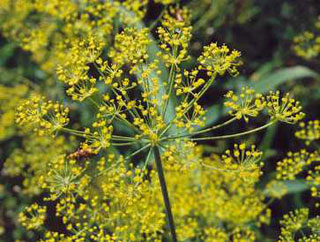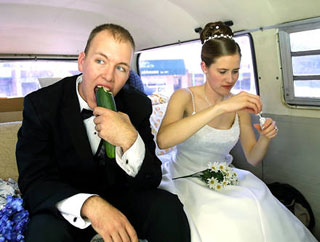Human Flower Project
Wednesday, August 23, 2006
Marrying or Pickling
Whether you’re making matrimony or sauerkraut, dill’s the thing.

Anethum graveolens in bloom
Photo: Gernot Katzer Spice Pages
The cucumbers are ripe in Oregon, prompting Linda Ziedrich to share her recipe for pickles with the Portland daily. Her instructions, calling for “1 fresh head and 1 frond of dill,” sent us off on the scent of this marvelous herb. You may not be familiar with dill as a cut flower, but it’s a beauty—its lacy umbels yellow as devilled eggs (we feel another recipe coming on…). On the taste-o-meter, chefs locate dill between anise and caraway, but we surely prefer it to either one. The flavor is much more pleasingly green, plus the feathery foliage looks good in or on whatever it touches (whereas caraway seeds, we find, bear an unhappy resemblance to fleas).
Anethum graveolens is native to Southern Russia and the lands of the Mediterranean, though it fares well in Asia and California, too. Hey, it even grows in Central Texas. We know because Frank and Pamela Arnosky include it in their beautiful Texas Specialty mixed bouquets—zinnias and sunflowers with a few airy heads of dill really make a statement. Gardener Sue Oberle also extols dill as a cut flower. This annual sounds easy to cultivate and to harvest—a survivor—putting it on our fall planting list.
 The groom enjoys a cucumber
The groom enjoys a cucumber
Photo: Jay P. Langhurst
Here’s a treat for all you dill-ettantes, Gernot Katzer’s “spice page,” which includes, among many other delights, the word for “dill” in 60 languages. Now that’s bound to come in handy. What’s usually referred to as dill seed, we learn, is actually the plant’s fruit, a favorite in breads, cheeses and salad dressing. “Dried dill shows up in Georgia’s famous spice mixture khmeli-suneli and is also quite popular in Iran, mainly for boiled beans.”
We discovered several references to dill as a wedding guest, though a number of discrepancies among herbalists and other plant psychologists about why the herb is invited. This site claims that flowering dill used to be common in bridal bouquets “because it was believed to promote desire. Following the ceremony, the dill was eaten for that purpose.” In traditional Egyptian weddings, the bride and groom take their places on a cermonial setee, called a kosha; Bayoumy Muhammad, owner of Queen florist in Zamalek, reports that “dill flowers are most often used to adorn the kosha as they can be easily arranged into heart-shaped designs or to form the first letters of the bride and bridegroom’s names.”
Another site calls dill “an antidote for victimization.” And yet another notes it soothes digestion and “destroyeth the hiccups.” We suppose newlyweds can use all of this help, and more. Why not tuck a pickle in the bride’s shoe, for resilence.




